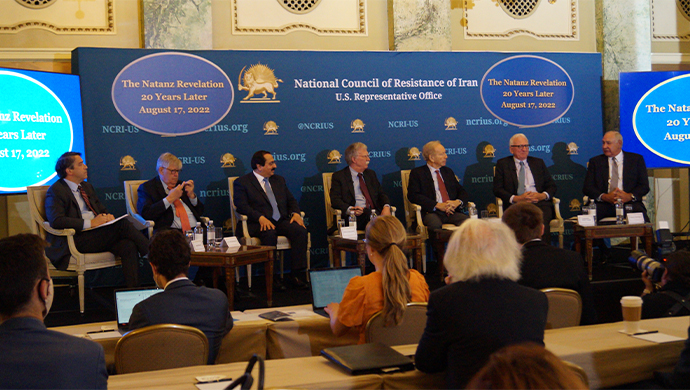The Iranian opposition coalition National Council of Resistance of Iran (NCRI) first unveiled the Iranian regime’s nuclear weapons program back in 1991. However, the August 2002 revelation of the Natanz uranium enrichment plant and Arak heavy water reactor site by the NCRI-U.S. Representative Office in Washington shook the international community to its core and triggered questions and follow-up inspections by the United Nations nuclear watchdog, the International Atomic Energy Agency (IAEA).
A few months later, the IAEA acknowledged the NCRI’s revelations and emphasized that without the details and information provided by the Iranian Resistance the international community would have not been informed about the regime’s clandestine nuclear program.
Dr. Olli Heinonen, the IAEA deputy director at the time, explained his first reaction and the importance of the NCRI revelations in a recent conference held by the NCRI-U.S. Representative Office in Washington marking the 20 anniversary of those revelations.
“It was the 15th of August when this message from DC reached us, and it changed my life entirely for a while… certainly there were some surprises in the briefing that [NCRI-U.S. Rep. Office Deputy Director] Alireza Jafarzadeh delivered. The IAEA was aware about some aspects of uranium enrichment in Iran. So, it didn’t come as a surprise such, but the magnitude was different, particularly when we saw the satellite images from Natanz because was not known to us,” Dr. Heinonen explained.
Other dignitaries taking part in this conference also emphasized that the NCRI’s revelations of the Iranian regime’s secret nuclear weapons program were astonishing.
“This revelation about Natanz for the U.S. government was incredibly important,” said Amb. John Bolton, former U.S. National Security Advisor. “I can tell you when Alireza had his press conference and word about the enrichment facility at Natanz got out and was increasingly well understood it had a dramatic impact publicly in this country and I think around the world because the palpable evidence that was presented made it inescapable that Iran had an advanced sophisticated nuclear program that was it was almost surely pointed to the development of nuclear weapons,” Amb. Bolton explained.
Senator Joseph Lieberman described the NCRI’s August 2002 revelations as “riveting” and “jarring.”
“What NCRI did and Alireza announced here in this hotel 20 years ago almost to the day was really extraordinary. Not the intelligence agency of our government, our allied governments with its great intelligence agencies. This was a non-governmental organization that revealed something that a lot of us, including on Capitol Hill, did not [know about]. We suspected it, but we didn’t have that evidence about the Natanz and Arak. And that led to the policy that followed after that. Quite remarkable really that a nongovernmental organization was able to do that the other thing it said to us, although we didn’t give it enough appreciation then, is at the NCR I was a credible organization with a significant support in Iran. You don’t issue a report that Alireza did here 20 years ago by making it up at a desk in Washington. This came from people inside Iran, inside the Iranian government who were resistors, courageous resistors, that led to this is,” Sen. Lieberman highlighted.
#Natanz20 Conference@JoeLieberman addresses question of “evolution” we have seen in part of both parties, on the issue of #Iran in the last 20 years.@AP @Reuters @AFP @thehill @WashTimes @washingtonpost@VOAfarsi @IranIntlbrk @IranIntl @RadioFarda_ https://t.co/oBAj0XgxqX
— NCRI-U.S. Rep Office (@NCRIUS) August 17, 2022
These remarks indicate that the international community was in neglect of the regime’s nuclear program. Twenty years after the NCRI’s August 2002 revelations, it has been proven time and again that the information and analysis provided by the Iranian Resistance regarding the regime’s nuclear program have been accurate.
“They (NCRI) are right 90 percent of the time,”
said New York Times senior science writer and Pulitzer Prize winner William J. Broad of the NCRI’s disclosures about Iran’s clandestine sites. “That doesn’t mean they’re perfect, but 90 percent is a pretty good record,” Mr. Broad said back in 2010.
If not for these revelations by the NCRI based on information provided by the network of People’s Mojahedin Organization of Iran (PMOI/MEK) inside Iran, the international community would almost certainly be dealing with a nuclear-armed Iranian regime that is also known as the world’s leading state sponsor of terrorism.
There is no doubt that Iranian regime Supreme Leader Ali Khamenei would have enhanced his global support for terrorism knowing that the pro-appeasement governments and institutions in the West would constantly seek a containment policy and be forced to accept the mullahs’ reign of belligerence.
This all the more indicates the importance of the NCRI’s continuing work and struggle against the mullahs’ regime, especially as the world is on the bring of yet another pro-appeasement decision of a possible return to the 2015 nuclear deal with Tehran.





